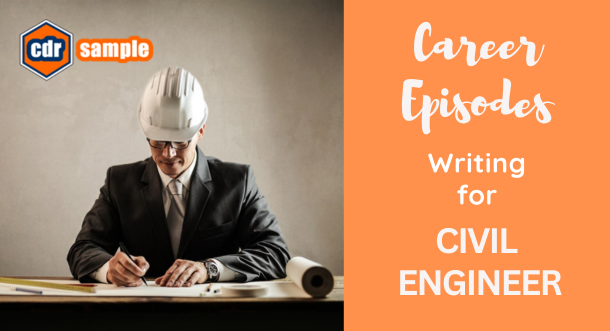As you came across this article, that focuses around the subject of How to Write CDR Career Episodes for Civil Engineer for migration skills assessment purposes with the Engineers Australia (EA), we would assume that you’ve already checked your ANZSCO code description and made sure that this is the right ANZSCO code for your application.
ANZSCO code description for Civil Engineering can be found on this website: https://www.abs.gov.au/statistics/classifications/anzsco-australian-and-new-zealand-standard-classification-occupations/2022/browse-classification/2/23/233/2332
To compose the Career Episodes for a Civil Engineer, you would need to adhere to a particular framework and incorporate pertinent details regarding your engineering experiences and abilities. This article provides important information to assist you in the process of drafting your Career Episodes.
CDR Career Episodes for Civil Engineer – selecting projects for your Career Episodes
The Career Episodes serve the purpose of showcasing your engineering skills and competencies by highlighting specific engineering projects or experiences, or even your university education (a Career Episode can be based on your final year Engineering Project).. Each Career Episode should demonstrate your abilities in relation to the Occupational Category and ANZSCO code for which you are applying, in this case – to the Civil Engineering ANZSCO code.
To showcase your skills and accomplishments in your engineering field, it is recommended that you select three notable projects or experiences from your career. It is important to choose episodes that encompass various aspects of your work and demonstrate a diverse range of competencies.
ANZSCO code description
To begin writing your Career Episodes, you must first comprehend the ANZSCO code description for a Civil Engineer – 233211. This code serves as a helpful reference in ensuring that your Career Episodes are focused on the necessary details. It is crucial to emphasize the responsibilities of a Civil Engineer in each Career Episode, as this will maximise your chances of passing the EA assessment.
The duties of a Civil Engineer according to the ANZSCO code description include
- Plans, designs, organizes and oversees the construction and operation of dams, bridges, pipelines, gas and water supply schemes, sewerage systems, airports and other civil engineering projects.
- Determines construction methods, materials and quality standards, and drafts and interprets specifications, drawings, plans, construction methods and procedures
- Organises and directs site labour and the delivery of construction materials, plant and equipment, and establishes detailed programs for the coordination of site activities
Below are examples of specific projects you might’ve undertaken as a Civil Engineer. Please notice that these are just some examples, projects you might’ve been involved in may be significantly different.
- Designing Aluminium Façade and panel fixing
- Designing reinforced concrete pile foundations.
- Designing floor plan layouts for residential buildings
- Designing the sizing and layouts of various types of drainage systems
- Designing beam reinforcements for floor and roof
- Designing concrete wall formworks
- Designing reinforced concrete slab
- Foundation designs including normal foundation, pile foundation, and micropile foundation
- Designing pile cap, tie beam, and pile layout
- Designing retaining wall structure
- Designing reinforced insulated footing
Knowledge and Competency Demonstration
In general, every Career Episode should consist of four parts: Introduction, Background, Personal Engineering Activity, and Summary. Among these sections, the most crucial one is the Personal Engineering Activity section. Here, you are required to describe two types of competencies – engineering and general competencies.
The engineering competencies pertain to design details, design calculations, and technical challenges you face while conducting a project. The design details cover the procedures undertaken to execute the designs, such as the considerations made in selecting a particular design and providing a description of the design process. It is essential to include any drawings created and specify the software utilized when discussing your designs. Examples of designs for Civil Engineering can be found above.
The design calculations refer to the numerical aspect of the designs and should include formulas, calculation examples, tables, simulation details, etc.
When discussing the technical challenges faced during the projects, it is crucial to focus on how you utilised your engineering expertise and abilities to resolve them. Additionally, incorporating relevant visuals such as diagrams, charts, tables, etc. can be beneficial.
Other parts of the engineering competencies include the engineering standards/codes you followed such as ISO, IEC, ASTM, etc.
The general competencies include your ability to cooperate/collaborate with your colleagues as a team, lead a team, engage with outside parties such as contractors and suppliers, effectively convey information through writing and speaking, enhance your knowledge and expertise by attending training sessions and conducting research, as well as considering economic factors that can impact the project.
Writing tips
When describing your personal involvement, use the first person and active voice. Start sentences with action verbs. Give specific details about your engineering tasks, methodologies, and technical skills employed.
Incorporating technical illustrations, tables, graphs, computations, photos, and calculation details. Highlight your prowess in troubleshooting, logical analysis, informed decision-making, and inventive approaches. It is important to note that if you use acronyms in your Career Episodes, it is advisable to provide explanations for them since the assessors may not be familiar with them.
In conclusion, writing your Career Episodes can be a demanding and time-consuming process. If you find yourself occupied or lacking experience, it is advisable to seek the assistance of a professional service. At CDRsample, our team of technical writers are experts in their respective engineering domains and possess over 14 years of collective industry experience.
We provide CDR writing services at a budget price. Our CDR writing services include the writing of three Career Episodes, Summary Statement, and CPD. Contact us today at cdr@cdrsample.com for a free consultation and free evaluation of your draft Career Episodes. Check out our services here: https://cdrsample.com/cdr-services/
Hope you found this article on how to write CDR Career Episodes for Civil Engineer useful, and if so, please share with your network.




